
Artists Respond to Human Behavior & the Environment
An Essay by Kim Abeles
Introduction
Each year, the Luckman Project provides a unique space for the interaction of students, professors, and a guest artist. Professors from the Department of Art select the students, seventeen this year, and I worked with them for two months to develop an exhibition, catalog, website, and a series of related events. The process became as much a metaphor for the intention of the show as the exhibit itself. Innovation, problem solving, and solutions are natural aspects of art production; students and the visitors to the exhibit had the opportunity to discover artwork that is visually potent and meaningful.
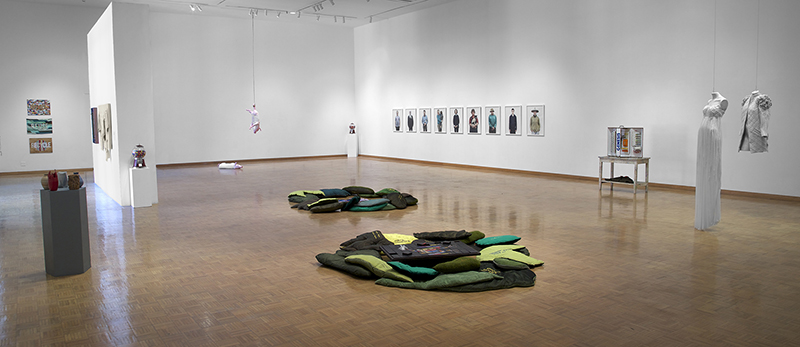
Installation View at Luckman Gallery
Background
In December 2014, I was a presenter with EcoArts Connections at the Behavior, Energy, and Climate Change Conference in Washington, D.C. and had the fortunate opportunity to meet with Dr. Elke Weber. Dr. Weber is part of the Center for Research and Environmental Decisions and a professor at Columbia University. She was instrumental in the development of the workbook, Connecting on Climate: A Guide to Effective Climate Change Communication (2014). The book begins with a brief overview of the way we have viewed climate change, and presents practical approaches for improving our behaviors within communities large and small. I was drawn to the idea that art can be part of the direction toward solutions for the ways that our daily living patterns effect the causes of climate change. The book provided me with a guideline for the Luckman Project, and solutions became the central focus.
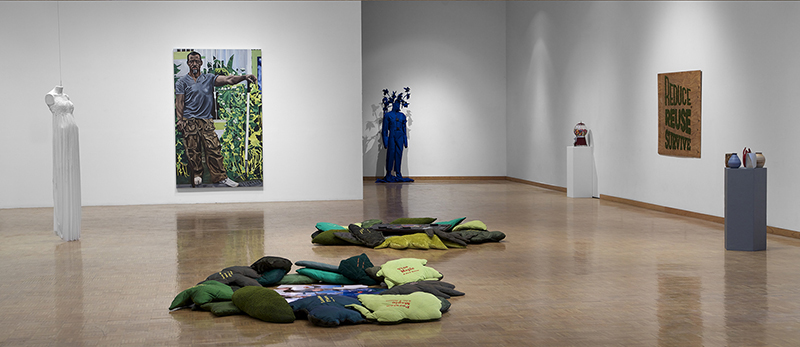
Installation View at Luckman Gallery
Snooze You Lose
As the GALLERY-OF-SOLUTIONS continued to develop, I ached every time I thought of climate change, wanting to drop the word from the mix. It simply sounded too big, too uncontrollable. I think my personal wrestling match with the idea of climate change is a testament to where many of us are now. This moment is one of opportunity. We don’t have to be distracted by skeptics, and we can direct our attention to personal changes and choices, to acknowledge our potential influence on corporate and governmental decisions. Make a shift in our awareness as citizens, and positive change moves in a beneficial direction.
Art, human behavior,
and climate change
This sort of exhibition brings up the issue of effectiveness. Do art projects like this help to make change? There is much to be learned from the students through our process and the resulting artwork. First, self-observation of behavior, and the way we move through each day, jumpstarts transformation. The more typical head-in-the-sand approach effects our actions more than we imagine, and self-reflection goes a long way toward improving crummy habits. Our attempts, awkward and inefficient at first, begin to shape more smoothly. Working together in groups creates unexpected relationships between shy and the bold inventions.
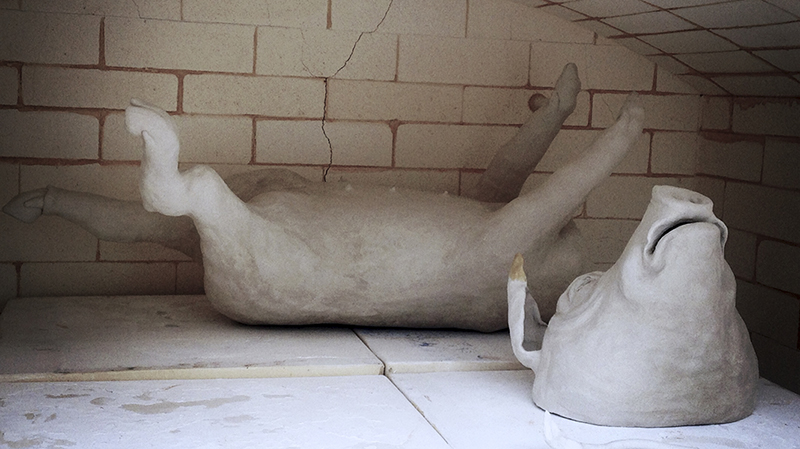
Lorren Ashley Lowrey, one of the ceramic sculptures in process for firing
Making artworks about subjects related to human impact on the environment evokes an undeniable change in the individual. One student in the exhibition, Lorren Ashley Lowrey, returned to vegetarianism after creating the two life-size, ceramic pigs for the installation, Auribus Teneo Lupum. The goal is to have the viewer find an entry into such tough subjects as factory farming, the environmental impact of grazing cattle for beef, and meat’s relationship to clear cutting of forests. Lorren would be the first to admit that it is idealistic to think that all of us would transform into vegetarians, but she advocates that one meat-free day a week is not too tough for anyone to tackle. Cumulatively, we move like a herd, ourselves, in a more substantial direction. Not a crash diet, but a philosophical change in attitude.
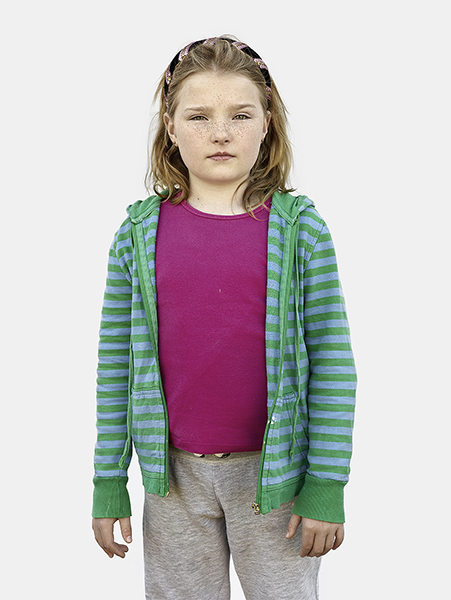
Calista Lyon, Celina from the project, Living Home
Calista Lyon photographed every person in her agricultural hometown in Australia, and selections from the 160 images of Living Home are presented in the exhibition. The power of this action, encouraging each person in the agrarian valley to participate in a portrait session, is truly profound; here is the act of acknowledgement, recognizing each individual, the importance of each person. As workers and farmers, this portrays a sense of trust in the photographer, and resists our world of Andy Warholian 15-second selfies.
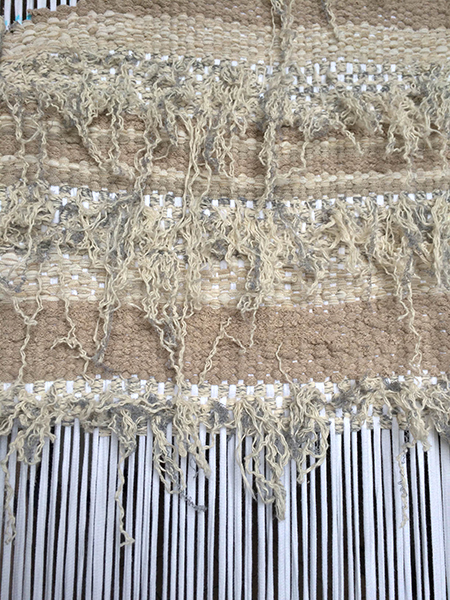
Cayetano Talavera, process of weaving for R3generation
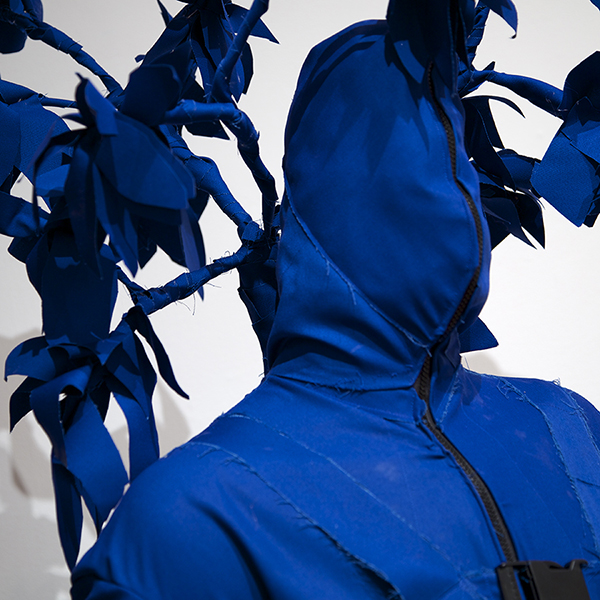
Alexander Lucero, detail of Airforce
Cayetano Talavera and Alexander Lucero share some connections because of their use of making wearable art and fashion from fabrics that would have ended up in a purgatory in the local landfill. Cayetano used test fabric strips that are used as samples in the garment industry. In a skillful, highly detailed reworking of the fabric strips, he creates a high couture ensemble that is runway ready and born as a Chanel. Both of the students transform scrap into something meaningful. Alex’s work retains its somber origin. His sculptural costume shouts with its Yves Klein Blue, and yet it is assembled from remnants from the construction of prison uniforms at the Pitchess Detention Center in Castaic, California. Pitchess has one of three sustainability programs in the California prison system, and everything from plastic recycling to re-purposing rice bags for making aprons, is part of the program. At the time I went to retrieve cast-off supplies, the blue uniforms were in production; and, Alex’s piece can’t help but teeter between the upbeat attitude about re-use, and the realities of the source of this fabric. The interrelatedness of our society and our environmental future are woven tightly together.

Detail of Sarah Evans’ quilted scraps and repurposed trash
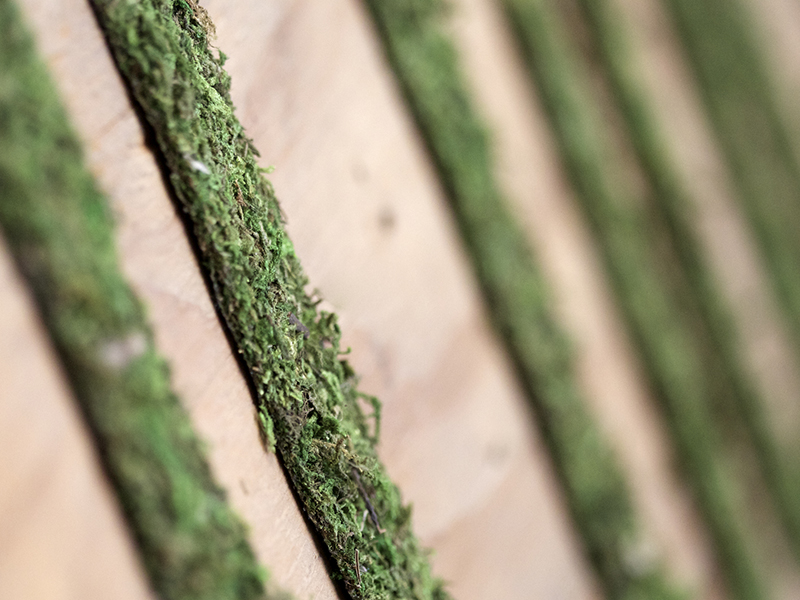
Detail of Thomas Nguyen’s moss on recycled plywood

Jesse Alvarez, from the series, Live in Color
Sarah Evans, Thomas Nguyen, and Jesse James Alvarez used the language of materials to enhance their messages. All three of them are from Graphic Design and Visual Communication, so it makes sense that they worked through ways to push words into the physical, tactile plane. Moss, refuse, fabric scraps, and recycled wood fragments transform sustainability terminology into a combination of typography and texture. Each of these artists also had the parallel desire to replace toxic art supplies, like spray paint, with materials that promote an alternative. Jesse’s silkscreened t-shirts emphasize in message and material, the use of soy waterbased inks rather than Plastisol ink on natural fiber. Their art becomes a model and sets an inspired example for others. All this is through an effort of research and experimentation. Jesse explains the issues with polyester fiber vs cotton, and in hindsight, hemp t-shirts would have been optimum because of the issues related to farming cotton, depletion, and pesticides among them. Printing on used t-shirts emerged as an alternative also. It brings up the fact that we feel our way through solutions. As we work through one solution, new issues arise.
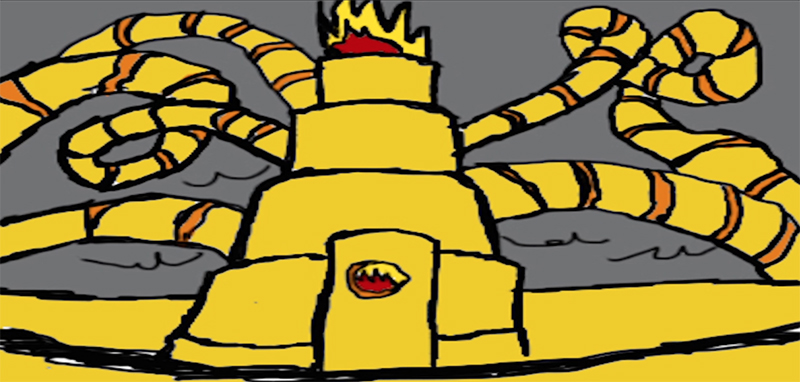
A drawing from Jonathan Winter’s animatic, Yamuna The Mermaid Musician
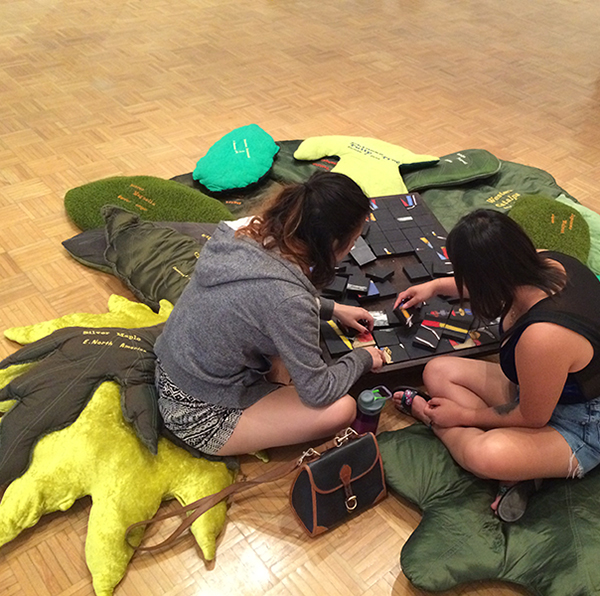
Visitors to the gallery with John Chen’s puzzle painting
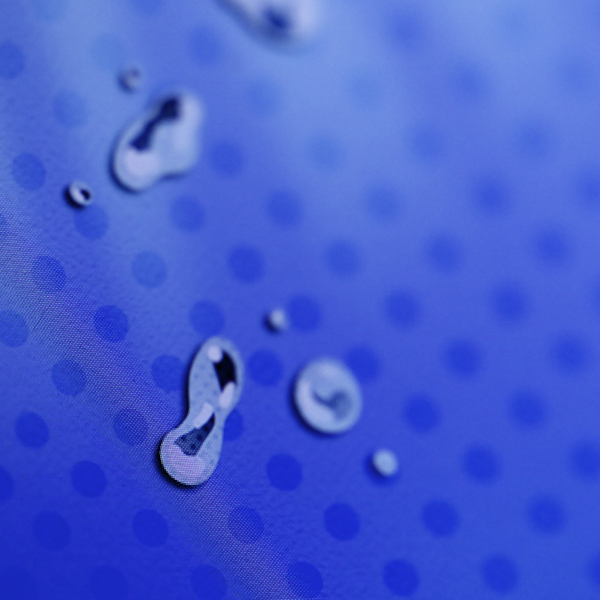
Detail of Judith Contreras’ insoluble
Several approaches considered future generations, emphasized by formats related to kids. Jonathan Roy Kendall Winter’s animatic uses the format of a children’s cartoon and creates a narrative that shifts an apocalyptic world to one of hope. Story-telling and symbolic characters reshape a polluted world into an image of renewal. John Chen and Judith Contreras both looked at the polluted world and ways to select a more positive image. Each used an interactive approach by creating large-scale puzzles that the viewers can assemble as a visual, physical, and symbolic gesture about pollution and alternative thinking. With the help of these puzzles, for visitors seated on the pillowed, gallery floor, the exhibition functions as an interactive space for viewers, a place to pause and reflect about one’s own role in behaviors that lead to the human impact on climate change.
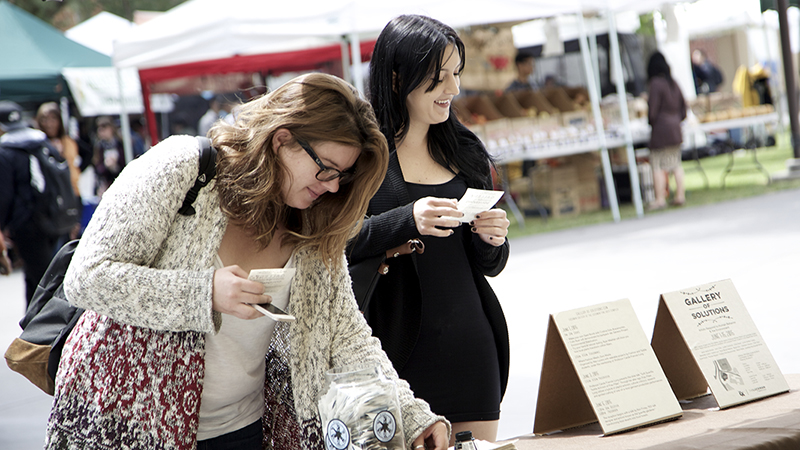
Cal State LA Farmer’s Market where visitors made “seed bombs”
Cristina Solis Bracamontes’ Sweet. Wild. Free. also required interaction. Her modified gumball machines contain seeds embedded in recycled paper, and pay homage to Kathryn Miller’s Seed Bombs created in the 1980s. Cris was one of the students who participated in a Cal State LA Farmer’s Market where passersby could make their own “seed bombs”. These activities created in tandem with the exhibit were intended to make a ripple effect for the projects’ influence. Call it an ice breaker to start the conversation on tough subjects.
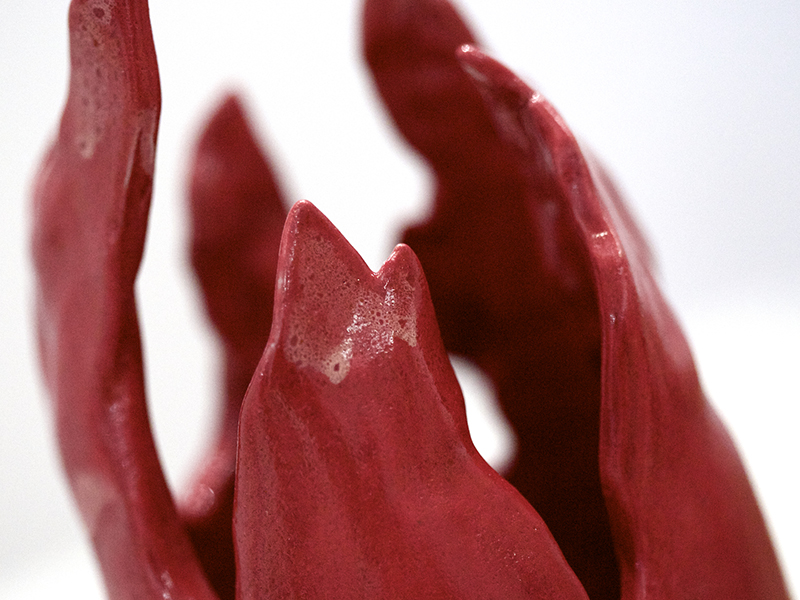
Detail of Julian Hsieh’s Wu Xing

Detail of Albert Vitela’s installation Swords into Plowshares
Julian Hsieh’s suite of vessels entitled, Wu Xing, presents both a metaphoric and physical expression. He has created Wu Xing, the five elements from Chinese culture. Each vessel presents one of the phases - water, fire, earth, wood and metal - and the presentation speaks of the interconnection between these elements. That which may overpower is also reliant on the others in the next moment. This describes a spiritual connection that we need to cultivate in our search to return to a healthy world. If one does not love the world, that same person will not feel a need to protect it. Albert Vitela’s assemblage sculpture and installation shares a similar desire. For Albert, the focus on peace and a world without weapons is imperative. He suggests a discussion about power and balance from a historical perspective, with images of Kennedy in a speech shown on a distorted television screen, and Kennedy as a monument, urging us to sanity. The sword in Albert’s piece becomes a plow, and calls to mind Kurt Vonnegut’s novel, Player Piano, when the mechanized world collapses yet the first thing the remaining people think to do is to put pieces back together to build something. Like Wu Xing, our ability to destroy is in balance with our desire to restore.

Colin Ryan, vials from Genesis Project
Bryan Ortiz and Colin Ryan work in very different ways, but their interest in the inventive leader or role model touches similar chords. Colin’s piece is based in a feasible character, oneself, who builds a backpack made to protect and galvanize the natural world with DNA from specimen samples. His piece gives us an imagined individual, the protector of the natural world, who is in the realm of labs and organizations that do indeed save seeds, for example, unaffected by the genetically modified organisms that have swiftly changed our food and fields to unrecognizable something-orother. An artwork like Colin’s, forces us to rethink our role in these changes we so easily accepted until now. What will you save?
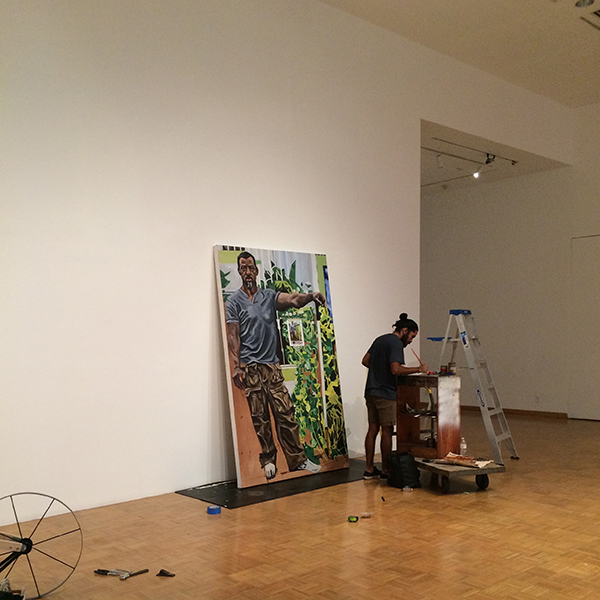
Bryan Ortiz working on the painting of Ron Finley
And, Bryan’s larger-than-life painting is a portrait of Ron Finley, the “renegade gardener.” Ron Finley is well known as a TED-talk speaker who has been instrumental in rallying for cities to allow vegetable gardens to grow in the small plots of land adjacent to sidewalks. Turning all those tickets he received for “illegal gardening” into a platform for dialogue, he continues to set his goals on changing “food deserts into food forests.” Bryan’s monumental, expressive portrait draws us into an energetic possibility of change. Who are these insightful people who really lead us each day? Maybe it’s my neighbor and maybe it’s me.
Faith and Pedagogy
Ryan Nicole Meehan’s artwork presents an “instructional” embroidered panel to portray foraging of local plants to cook and prepare for natural dyeing. All the artists in the show were directed to seek the best route in terms of materials, processes, and reduction of waste. In the case of Ryan’s artwork, everything about it kept to a pure value of observance. In addition to the natural elements within the work (local plants), everything she used was re-purposed, and anything she needed to “buy” was attained through barter. This pertained also to the hiring of a local guide who helped her find plants in the Angeles National Forest.
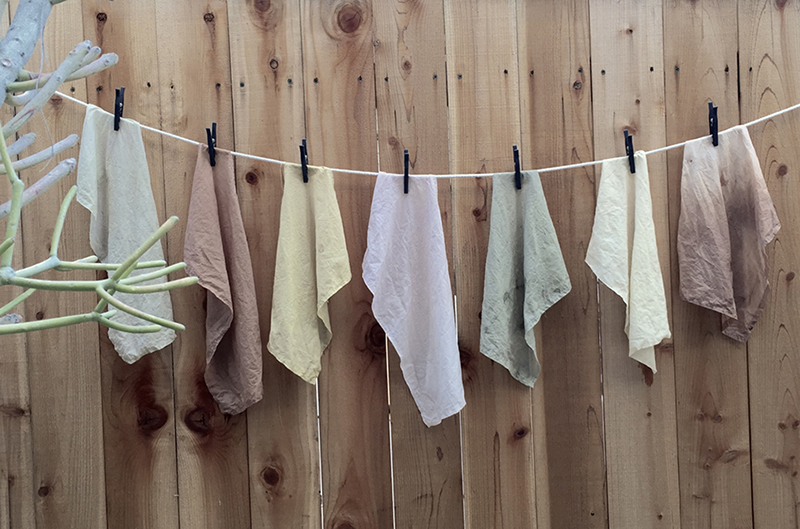
Ryan Meehan’s natural dyeing in process
Ryan’s work is emblematic of many of the other artists in the show when it comes to the power of learning. Rather than coming to issues about climate change with preconceptions, the artists transformed through investigation, experimentation, and openness. Our challenge is to come to problem-solving with a humble core within ourselves. Our best bet is to see our place within community, to learn from each other, to be fearless about trying new approaches.
I was looking to see what solutions would look like for students in this project, looking to them for answers. The interconnectedness of everything requires positive energy and consideration to come from multiple topics, directions, and temperaments. Process is messy and requires faith in the accumulative power of the good efforts by many, despite the odds. The key is really awareness, and not in the sense of “me” as we usually think of that, but in the sense of “me” as one part in the bigger picture. This is a fruitful time for students to see that potential.
Kim Abeles
Visiting Artist, 2015 Luckman Project